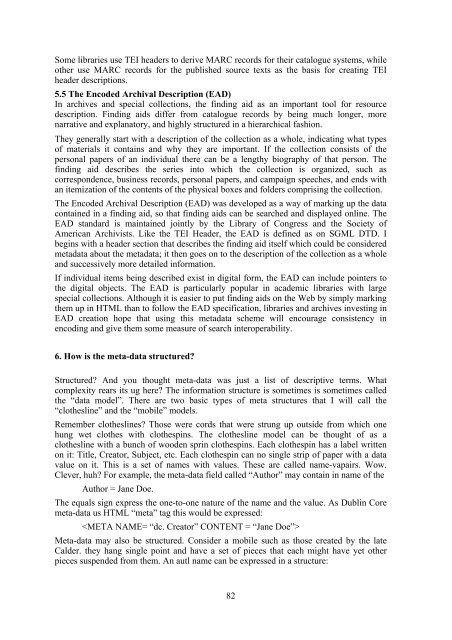7 - Indira Gandhi Centre for Atomic Research
7 - Indira Gandhi Centre for Atomic Research
7 - Indira Gandhi Centre for Atomic Research
Create successful ePaper yourself
Turn your PDF publications into a flip-book with our unique Google optimized e-Paper software.
Some libraries use TEI headers to derive MARC records <strong>for</strong> their catalogue systems, while<br />
other use MARC records <strong>for</strong> the published source texts as the basis <strong>for</strong> creating TEI<br />
header descriptions.<br />
5.5 The Encoded Archival Description (EAD)<br />
In archives and special collections, the finding aid as an important tool <strong>for</strong> resource<br />
description. Finding aids differ from catalogue records by being much longer, more<br />
narrative and explanatory, and highly structured in a hierarchical fashion.<br />
They generally start with a description of the collection as a whole, indicating what types<br />
of materials it contains and why they are important. If the collection consists of the<br />
personal papers of an individual there can be a lengthy biography of that person. The<br />
finding aid describes the series into which the collection is organized, such as<br />
correspondence, business records, personal papers, and campaign speeches, and ends with<br />
an itemization of the contents of the physical boxes and folders comprising the collection.<br />
The Encoded Archival Description (EAD) was developed as a way of marking up the data<br />
contained in a finding aid, so that finding aids can be searched and displayed online. The<br />
EAD standard is maintained jointly by the Library of Congress and the Society of<br />
American Archivists. Like the TEI Header, the EAD is defined as on SGML DTD. I<br />
begins with a header section that describes the finding aid itself which could be considered<br />
metadata about the metadata; it then goes on to the description of the collection as a whole<br />
and successively more detailed in<strong>for</strong>mation.<br />
If individual items being described exist in digital <strong>for</strong>m, the EAD can include pointers to<br />
the digital objects. The EAD is particularly popular in academic libraries with large<br />
special collections. Although it is easier to put finding aids on the Web by simply marking<br />
them up in HTML than to follow the EAD specification, libraries and archives investing in<br />
EAD creation hope that using this metadata scheme will encourage consistency in<br />
encoding and give them some measure of search interoperability.<br />
6. How is the meta-data structured?<br />
Structured? And you thought meta-data was just a list of descriptive terms. What<br />
complexity rears its ug here? The in<strong>for</strong>mation structure is sometimes is sometimes called<br />
the “data model”. There are two basic types of meta structures that I will call the<br />
“clothesline” and the “mobile” models.<br />
Remember clotheslines? Those were cords that were strung up outside from which one<br />
hung wet clothes with clothespins. The clothesline model can be thought of as a<br />
clothesline with a bunch of wooden sprin clothespins. Each clothespin has a label written<br />
on it: Title, Creator, Subject, etc. Each clothespin can no single strip of paper with a data<br />
value on it. This is a set of names with values. These are called name-vapairs. Wow.<br />
Clever, huh? For example, the meta-data field called “Author” may contain in name of the<br />
Author = Jane Doe.<br />
The equals sign express the one-to-one nature of the name and the value. As Dublin Core<br />
meta-data us HTML “meta” tag this would be expressed:<br />
<br />
Meta-data may also be structured. Consider a mobile such as those created by the late<br />
Calder. they hang single point and have a set of pieces that each might have yet other<br />
pieces suspended from them. An autl name can be expressed in a structure:<br />
82
















